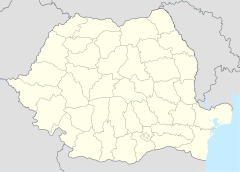モビラ洞窟
ルーマニアにある洞窟
座標: 北緯43度49分32秒 東経28度33分38秒 / 北緯43.825694度 東経28.560556度
モビラ洞窟(Movile cave)は、黒海湾岸から数km離れた、ルーマニアのコンスタンツァ県マンガリアにある洞窟である[1]。1986年にクリスティアン・ラスクが発見した。硫化水素と二酸化炭素が豊富で酸素が少ない独特の地下水生態系で有名である。ここの生物は、過去550万年にわたり外界と隔離され、光合成ではなく化学合成に完全に依存している[1]。
| モビラ洞窟 | |
|---|---|
| ルーマニア語: Peștera Movile | |
| 所在地 | コンスタンツァ県マンガリア近郊(ルーマニア) |
| 座標 | 北緯43度49分32秒 東経28度33分38秒 / 北緯43.825694度 東経28.560556度 |
| 発見 | 1986年 |
| 洞口数 | 1つ(人工) |
| 危険性 | 低酸素大気(危険な濃度の二酸化炭素、硫化水素、アンモニア) |
| 特徴 | 化学合成を元にした独特な生態系を含む密閉された洞窟 |
化学環境
編集洞窟内の空気は、外の大気とかなり異なる。酸素濃度は、外界の3分の1から半分程度の7-10%で、二酸化炭素濃度は約100倍の2-3.5%である。1-2%のメタンも含む。また、洞窟内の空気と水の両方に高濃度の硫化水素とアンモニアが含まれる[2]。
生態
編集ヒル、クモ、カニムシ[3]、ワラジムシ[4]、ムカデ[5]、タイコウチ[6]、カタツムリ[7]等、57種類[8][9]の動物が知られている。そのうち、37種が固有種である[8][9]。食物連鎖は、メタン菌や硫黄細菌による化学合成が起点となり、菌類や細菌の栄養素を放出している。これらが洞窟の壁面や湖の水面に微生物マットを形成し、数種の動物の餌となり、さらに捕食者に捕食される[10]。Nepa anophthalmaは、世界で唯一の洞窟に適応したタイコウチである[6]。この洞窟内で、動物は5500万年間、生存しているが、全てが同時に発生した訳ではない。記録された最も最近の動物は、洞窟に棲む唯一のカタツムリであるHeleobia dobrogicaで、この洞窟で発生して200万年余りになる[3][1][7]。
関連項目
編集出典
編集- ^ a b c Fox-Skelly, Jasmin (4 September 2015). “The bizarre beasts living in Romania's poison cave”. BBC Earth
- ^ Kumaresan, Deepak; Wischer, Daniela; Stephenson, Jason; Hillebrand-Voiculescu, Alexandra; Murrell, J. Colin (16 March 2014). “Microbiology of Movile Cave?A Chemolithoautotrophic Ecosystem”. Geomicrobiology Journal 31 (3): 186?193. doi:10.1080/01490451.2013.839764.
- ^ a b Nag, Oishimaya Sen (25 April 2017). “Movile Cave - An Oddity Of Romania”. WorldAtlas
- ^ Karen Graham: Movile Cave in Romania has an ecosystem unlike any other on Earth. In: DigitalJournal. 25 May 2016. Source: Science
- ^ Varpu Vahtera, Pavel Stoev, Nesrine Akkari: Five million years in the darkness: A new troglomorphic species of Cryptops Leach, 1814 (Chilopoda, Scolopendromorpha) from Movile Cave, Romania. On: ZooKeys 1004: pp 1-26. doi:10.3897/zookeys.1004.58537 (16 December 2020)
- ^ a b Decu, Vasile; Gruia, Magdalena; Keffer, S. L.; Sarbu, Serban Mircea (1 November 1994). “Stygobiotic Waterscorpion, Nepa anophthalma, n. sp. (Heteroptera: Nepidae), from a Sulfurous Cave in Romania”. Annals of the Entomological Society of America 87 (6): 755?761. doi:10.1093/aesa/87.6.755.
- ^ a b Andrzej Falniowski, Magdalena Szarowska, Ioan Sirbu, Alexandra Hillebrand, Mihai Baciu: Heleobia dobrogica (Grossu & Negrea, 1989)(Gastropoda: Rissooidea: Cochliopidae) and the estimated time of its isolation in a continental analogue of hydrothermal vents. In: Molluscan Research 28(3): pp 165-170. 22 Dec 2008. ISSN 1323-5818
- ^ a b GESS Lab. (2020). Movile Cave - a unique ecosystem. Gesslab. https://www.gesslab.org/movile-cave
- ^ a b GESS Lab. (2020a). List of invertebrate species encountered and described in the Movile Cave ecosystem. https://fecc112f-3776-4476-a602-1572b7478186.filesusr.com/ugd/1e4de5_ebb50699a75848bbb0c3f12a65da4c5d.pdf
- ^ “Microbial food webs in Movile Cave”. UK Research and Innovation. 2022年10月4日閲覧。
- Jean Balthazar: Grenzen unseres Wissens. Orbis Verlag, Munchen 2003, Seite 268, ISBN 3-572-01370-4.
- Sarbu, Serban M.; Kane, Thomas C.; Kinkle, Brian K. (28 June 1996). “A Chemoautotrophically Based Cave Ecosystem”. Science 272 (5270): 1953?1955. doi:10.1126/science.272.5270.1953. PMID 8662497.
- Wischer, Daniela; Kumaresan, Deepak; Johnston, Antonia; El Khawand, Myriam; Stephenson, Jason; Hillebrand-Voiculescu, Alexandra M; Chen, Yin; Colin Murrell, J (January 2015). “Bacterial metabolism of methylated amines and identification of novel methylotrophs in Movile Cave”. The ISME Journal 9 (1): 195?206. doi:10.1038/ismej.2014.102. PMC 4274414. PMID 25050523.

